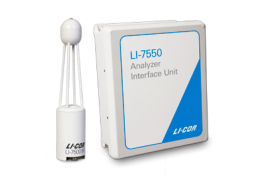The LI-7500A CO2/H2O Analyzer optical windows are easy to clean. Cleaning the windows removes any accumulated dirt or dust that reduces the optical signal being measured. Complete cleaning instructions are described in the LI-7500A instruction manual.
Typically, after cleaning, the variables used for indicating optical signal (AGC in version 6.0 and below; Signal Strength in version 6.5 & above) will improve. Cleaning the optical windows under certain conditions can cause the AGC or Signal Strength to temporarily decease. This is a result of the exposure of the optical detector, located behind the top window of the optical cell, to Ultraviolet (UV) light during the cleaning procedure. This exposure reduces the signal throughput of the system across all wavelength channels.
This deterioration of the optical signal indicator does not cause an error in the analyzer measurement, because the LI-7500A measures light absorption of CO2 and H2O molecules using a ratio of the sample and reference optical channels. Figure 1‑1 (A through D) shows typical instrument performance after exposure to UV light using a UV LED. The analyzer performance does not appreciably change, even after a 30% deterioration in the optical signal indicator.
After the instrument is exposed to a dosage of UV, it may take several weeks for the optical signal indicator to recover to preexposure levels, but it will eventually do so. To accelerate the signal indicator recovery, turn the instrument off (remove power) for 3 to 4 days.
To avoid optical signal indicator deterioration under UV light, simply avoid allowing sunlight to shine directly into the upper optical windows during cleaning. This can be achieved by putting any nonreflective material over the top window. This material can be a plastic plug, a dark cloth or simply covering the window with a thumb. Clean the bottom window first while keeping the top window covered, and then proceed to clean the top window (there is no need to cover the bottom window while cleaning the top). Alternatively, the instrument could be opened for cleaning under low UV light conditions.

